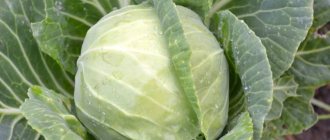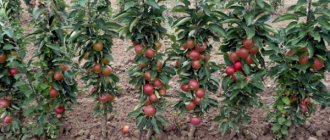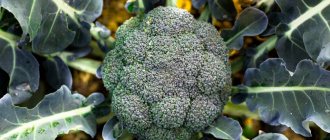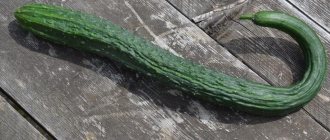This article discusses the best varieties of early cabbage of various varieties with photos: white cabbage, red cabbage, savoy cabbage, cauliflower, broccoli, kohlrabi and others. Which varieties of early white cabbage are suitable for different regions.
Early ripening cabbage is one of the most popular vegetables. Early varieties of cabbage are rich in vitamins (especially C, B9, K, U), mineral elements, carbohydrates, and biologically active substances.
It is not recommended to apply large amounts of nitrogen fertilizers to this crop, since there is a danger of excessive accumulation of nitrates. Restrictions also apply to chemical pesticides.
When planning planting, one must take into account that the early cabbage crop needs to be quickly consumed and processed. An accurate calculation of the number of plants and harvesting time is important.
Features of early cabbage
Early ripening varieties of cabbage have a short growing season, which allows you to harvest the vegetable in early June, and in some regions at the end of May. But, due to the rapid ripening time, its heads are usually small in size, loose compared to late varieties and susceptible to cracking.
Planting early cabbage requires less land due to its small size, but abundant watering and increased feeding are required due to intensive growth.
Early cabbage is distinguished by its taste, or rather, by its limited difference. If mid- and late-ripening varieties can be distinguished by taste, then in the case of early cabbage this can only be done by a specialist.
On the other hand, this cabbage is very rich in vitamins and beneficial microelements. Due to the high water content in the leaves, these varieties are not suitable for harvesting and long-term storage. They are usually used for salads and seasonal dishes.
For the Urals and Siberia
Considering the climatic conditions of these regions, it is necessary to give preference to varieties with increased endurance, as well as an accelerated rate of ripening due to the short summer. About 50 types of white cabbage are included in the State Register of Russia, the cultivation of which is permissible in the Urals and Siberia. But among them there are those that are most in demand among gardeners. This is explained not only by their productivity, but also by their unpretentiousness.
The best types of white cabbage for regions with difficult climatic conditions.
Siberian 60
An old Russian variety, which is distinguished by medium, dense heads of cabbage, weighing 2.5-4 kg. The outer leaves are light green with a waxy coating, the inside of the fruit is snow-white. Cabbage is juicy, crispy, and contains a lot of sugars.
Hope
See the description of this variety above.
Number one Gribovsky 147
A time-tested variety. Belongs to the early category, the fruits reach technical maturity 100 days from the moment of emergence. The heads of cabbage are flat-round, weighing 1-2 kg. The yield of the variety is 6-8 kg.
Megaton
See the description of this variety above.
Slava 1305
See the description of this variety above.
Arctic
See the description of this variety above.
Transfer
See the description of this variety above.
June
See the description of this variety above.
Rotunda
Dutch mid-early hybrid, characterized by drought resistance and high immunity to fusarium. The duration of the growing season is 80-90 days. Suitable for fresh consumption and processing. When optimal conditions are created, the crop retains its consumer properties for up to 4 months. Forms round heads of cabbage weighing up to 2.7 kg.
Growing time
Most often, early varieties of cabbage are grown in seedlings in order to get the harvest as early as possible. Typically, seeds for seedlings are sown in the middle or end of March, depending on the region of planting. In order to accurately determine when to sow early cabbage, you need to take into account the following factors:
- Cabbage variety. What type of cabbage are you going to use, and what age should the seedlings be before planting? This information is placed on the back of the variety description; the age of seedlings for planting in the ground can vary from 30 to 55 days.
- Drop zone. What climate zone do you live in, and when weather conditions allow you to plant seedlings in the ground.
- Method of planting seedlings. Where are you going to plant the seedlings: in a greenhouse, under film or in open ground. Naturally, seedlings can be planted in a greenhouse 1-3 weeks earlier because the soil in it warms up better and faster.
- Moon calendar. When planting plants, many gardeners pay attention to the phases of the moon and plant cabbage in accordance with the recommendations of the Lunar Sowing Calendar. Now they are being expanded, with recommendations for favorable planting days for each crop.
It’s quite easy to calculate the landing time yourself. Look at the age of seedlings recommended by the manufacturer for planting in the ground. By this time, add 7-10 days for the emergence of seedlings and 7-10 days for the restoration of seedlings if you want to grow them with picks. Decide when you will plant the seedlings in the ground and count back the resulting number of days from this time.
Recommendations for choosing planting material
To get a high yield of early and ultra-early products without wasting extra effort and time, it is important to choose the right planting material.
When purchasing, we advise you to pay attention to several key points:
- recommended regions for cultivation;
- maturation period;
- resistance to common diseases;
- cabbage parameters (weight, taste, appearance);
- productivity.
You should purchase cabbage seeds that are zoned for a specific region and well adapted to climatic conditions, otherwise the result will be very disappointing. It is also advisable to give preference to varieties that are resistant to fungal diseases, which will allow you to do without chemical treatments or limit yourself to minimal protective measures.
Manufacturers usually place information about zoning and sustainability on packages with planting material; they can be checked against the State Register of the Russian Federation
Vegetable growers often have a question about what is better to choose: a variety or a hybrid. Brief information that we hope will help you understand these concepts is given in the table:
| Properties | Variety | Hybrid F1 (hybrid variety) |
| Advantages | Plants have stable characteristics and pass on their qualities to subsequent generations, so you can independently obtain good seeds for further cultivation; planting material is affordable | Plants have good vigor, are one-dimensional, generally resistant to adverse weather conditions and diseases; characterized by increased productivity, marketability, and transportability; make it possible to obtain high profits from industrial cultivation |
| Flaws | Product heterogeneity is possible; varieties may be inferior to hybrids in some respects (yield, weight of heads, disease resistance, etc.) | Improved properties appear only in the first generation, so each season you need to purchase new planting material, which is not cheap |
Modern highly productive hybrids are intended primarily for commercial cultivation for the purpose of commercial production
Preparing the site for planting
Early cabbage requires a small plot of land, but it must be fertile. This plant is very light-loving, so it is advisable that the planting site is not shaded. The best precursors for cabbage are legumes, cucumber, tomato, potato, and onion.
Cabbage crops grow very poorly in acidic and infertile soils. If you have just such soil, but there is no way to significantly improve its condition, do not be discouraged. There are several varieties of early ripening cabbage that grow even in infertile areas. An example of such a variety is Kazachok brand cabbage.
The area for planting has been prepared since the fall. The earth is dug up to a depth of 30 cm and manure or humus is added at the rate of 4 kg per square meter. m. How much mineral fertilizer and lime to apply is calculated based on the composition of the soil. On average, 40 g of superphosphate and 20 g of potassium chloride are consumed per 1 square meter. m.
In the spring, mineral fertilizers are added to the prepared soil again: 40 g of superphosphate, 15 g of potassium chloride, 15 g of urea. They are embedded in the top layer of soil using a rake.
The listed fertilizers can be replaced with 60-90 g of nitroammophoska; if there are no mineral fertilizers, add ash at the rate of 40 g for each hole. Or you can purchase specialized complex fertilizers specifically for cabbage; there is currently a large selection of such products on the shelves.
If fertilizers were not applied either in the fall or in the spring, then they are added to each hole when planting. Fertilizers are very important for cabbage, especially mineral ones, because they are sources of nitrogen, phosphorus and potassium, which are so necessary for the normal development of the head of cabbage:
- A lack of nitrogen is manifested by lethargy of the leaves and a change in their color to pale yellow; with severe starvation, the lower leaves turn blue or red.
- If a plant lacks potassium, dark spots appear on the leaves and grow. The leaf withers, curls and may fall off.
- With a lack of phosphorus, the leaves begin to darken, acquire a dark green, purple color, and the growth and development of the head of cabbage stops.
Seedling growing method
In order to get cabbage as early as possible, it is best to use the seedling growing method. In this way, you will protect the plant at a young age from pests and diseases and ensure the formation of full-fledged heads of cabbage with a long growing season.
Preparing seeds for sowing
Seeds sold, as a rule, are already sorted and disinfected and do not require additional processing. If you bought seeds of questionable quality, or use your own material, then it is necessary to carry out pre-sowing preparation.
Against clubroot and other fungal diseases, the seeds are placed for 20 minutes in warm water heated to 50 degrees. The water temperature is maintained at the same level. Then the seeds are placed in cool water for 3-5 minutes and dried thoroughly.
During the disinfection process, floating and small seeds are removed.
There are two ways to grow seedlings: potted and potless. In both cases, sowing seeds can be done with or without further picking.
Pot method
Recently, potted seedlings have been increasingly used. Its advantage is good survival rate, because the root system is kept intact before planting.
If you want to grow early cabbage seedlings without picking, then sowing should be done from late February to mid-March. Preparing the soil for seedlings includes mixing soil and humus in equal parts and adding mineral fertilizers: 30 g of superphosphate, 15 g of potassium nitrate, 10 g of ammonium nitrate per bucket of the mixture. Or any complex fertilizer for cabbage.
Young plants do not tolerate high salt concentrations well. Therefore, only half the dose of fertilizer is added to seedling mixtures based on humus and turf soil. If there are no signs of starvation, seedlings may not be fed.
As a soil for seedlings, you can use transitional or lowland peat with the addition of sand and sawdust. In the absence of microfertilizers, ash is added to the soil mixture at the rate of 2 cups per bucket.
When the soil for seedlings is prepared, you can start sowing:
- Sow 2-3 cabbage seeds into each container at a depth of 1.5-2 cm in order to select the most successful seedling in the future. After sowing, water the soil generously with water at room temperature. For faster germination of seeds, the pots can be covered with film.
- Maintain the seeded material at a temperature of 25 degrees until seedlings emerge. Then lower the temperature to 8-10 degrees to avoid stretching the seedlings. With the appearance of the first true leaf, raise the temperature to 15-17 degrees during the day and to 10 degrees at night.
- Lowering the temperature at night is necessary so that the seedlings do not grow pampered. Such seedlings do not take root well in the soil. Good seedlings ready for planting in the ground should be stocky and have 4-5 true leaves.
- Keep the soil moderately moist during the growing process to prevent the plant from becoming infected with blackleg. If you discover this disease, ventilate the room and sprinkle the soil with the plant with dry sand. To protect against diseases, add potassium permanganate (3 g per 10 liters of water) to irrigation water.
Potless method
When growing in large volumes or when there is not enough space, use a potless method of growing seedlings. To do this, place the prepared wet mixture in an even layer of 5-6 cm in the boxes and make grooves at a distance of 3-4 cm from one another.
In the phase of 1-2 true leaves, pick the seedlings into pots measuring 6 by 6 cm, or thin out the plants at a distance of 5-6 cm without picking. In potless seedlings, only 10% of the volume of the root system is retained during transplantation.
Potless method with preservation of the root system
There is another way to grow seedlings, which does not involve the use of containers, but it keeps the root system as intact as possible. With this method, pots are formed from well-moistened soil mixture.
To prevent the soil from crumbling when watering, mullein is added to it as a binding material. Its consumption should be no more than 0.5 liters per 1 bucket of mixture. Be careful when preparing this composition, because an excess of mullein will make the soil too dense, which will adversely affect the development of seedlings.
Place the wet mixture in an even layer of 5-6 cm in boxes or directly on the covered soil in a greenhouse, compact it slightly, and then cut along the entire height along and across, forming cubes 6 by 6 cm.
Transam F1
Even beginners can grow this unpretentious variety. Cabbage does not require special agricultural care and adapts perfectly to weather and climate changes. The variety produces good cabbage yields; the weight of the heads varies between 5-5.5 kg. The light-colored leaves are tender and tasty. The fruits of this variety are consumed both fresh and for preservation, ideal for pickling. Kochnaya are not affected by thrips and other pests and are resistant to many diseases. They tolerate transportation well and retain their presentation for a long time.
Seedless growing method
Early cabbage can also be grown using the seedless method, but in this case the harvest will ripen a little later. Most varieties of cabbage tolerate light frosts, but if you want to sow cabbage directly in open ground, carefully read the instructions for the variety you are going to cultivate.
Planting dates are determined by the region of residence and climatic conditions. For example, in central Russia, early cabbage can be planted in the first ten days of May. For this method, film covers or plastic bottles are used if the planting volume is small.
Sow the seeds with a reserve in prepared, moistened soil to a depth of 2-3 cm and cover. In the future, make sure that the soil in the sowing areas is always moist. When the plants have formed 3 true leaves (in about a month), the covering material can be removed.
Express
This super early cabbage is planted only by seedlings. After the first shoots appear, the vegetable ripens within 2-3 months. The plant is compact in size, with small leaves and a small raised rosette.
The average weight of one head of cabbage is 900-1300 g. Individual specimens grow weighing up to one and a half kilograms.
To obtain a good harvest, it is recommended to pre-treat the seeds.
Advantages:
- high content of dry matter and organic sugars;
- friendly maturation of the heads;
- the ability to harvest 2 times per season;
- crack resistance.
Flaws:
- low resistance to diseases;
- susceptible to attack by pests.
Good to know: Why cabbage does not form forks
Planting cabbage in open ground
Cabbage, like most plants, grows best with a square planting method, when the row spacing is equal to the planting spacing. However, many gardeners, for ease of care, plant cabbage in one row spacing 60-70 cm wide.
With this method of cultivation, the planting step for early ripening cabbage is 30-35 cm. If you are late in planting seedlings or your site is low-fertile, you need to increase the row spacing to 80 cm and plant cabbage less frequently.
Before planting, inspect the seedlings - discard weak, underdeveloped plants, as well as those with signs of disease. It is advisable to carry out work on selecting and planting seedlings in the afternoon, towards evening.
The next steps look like this:
- form holes 10-12 cm deep;
- add a handful of humus and 2 tablespoons of ash or mineral fertilizers to each hole according to the instructions;
- thoroughly pour at least 2 liters of water into the holes;
- if the seedlings were grown using a potless method, before planting, dip its roots in a liquid solution of clay and mullein;
- when planting plants, deepen the root collar 2-4 cm to the first leaf, but do not cover the apical bud;
- squeeze the soil around the cabbage, water it and sprinkle it with dry soil so that a crust does not form;
After planting, it takes 10-14 days for rooting. At this time, the seedlings have reduced frost resistance, so a film shelter needs to be built over them.
About growing early cabbage - from planting seedlings in the ground to harvest - watch the video:
Mirror
An ultra-early variety bred by Dutch breeders of the Syngenta company. Gives a high yield on clay soils and fertile peat lands. The growing season lasts 45-50 days. Planting of seedlings is carried out at the end of April or beginning of May. The culture is unpretentious in care. Regular watering is required, but water stagnation should not be allowed.
Mirror is valued for its productivity and stable yields. Tolerates temperature fluctuations well and has strong immunity to diseases (with the exception of powdery mildew).
The vegetable is easy to transport, as it does not lose its presentation.
Caring for early cabbage
Care consists of weeding, loosening, regular watering and fertilizing of plants. Watering is carried out on the second day after planting the seedlings in the ground and subsequently watered at least 1-2 times a week.
During the period of head formation, cabbage experiences a particularly high need for water. However, closer to the harvest time, watering should be reduced to prevent the vegetable from cracking.
Usually two feedings are carried out. When the plant takes root, it is fed with mullein diluted with water in a ratio of 1:10, 0.5 liters per plant. When heads of cabbage begin to set, the cabbage is fed with nitrogen-potassium fertilizers.
It is important to keep the soil under cabbage loose and not allow it to dry out. Loosening is carried out after rains and waterings. At the same time, the cabbage can be lightly hilled. Hilling promotes the appearance of secondary roots on the stem.
Oracle
An early ripening hybrid, the ripening period of which is 55 days. It is recommended to grow Oracle under covering material. The fruits are round and dense. The leaves are powerful, with a waxy coating.
Advantages:
- simultaneous maturation of the heads;
- resistance to lack of moisture and temperature fluctuations;
- beautiful presentation;
- high resistance to fusarium;
- good transportability.
Growing cabbage in a greenhouse
When growing cabbage in greenhouses, the same steps are performed as when growing in open ground. But this method has a number of advantages:
- the harvest can be obtained earlier, since the soil in the greenhouse warms up faster;
- in the greenhouse it is easier to maintain the required temperature conditions;
- no need to worry about the weather, plants will not be damaged by hail or strong wind;
- cabbage is more resistant to late blight in a greenhouse atmosphere;
- vegetables suffer much less from the invasion of harmful insects.
Harvest the heads of cabbage as they ripen, preventing them from cracking.
Ultra-early miracle
Cabbage attracts many gardeners with its external characteristics. Cultivation in greenhouse conditions is allowed. It is considered one of the leaders in early ripening, because the growing season takes only 60-70 days. The heads of cabbage are round, slightly flattened, and small in size. The leaves are juicy, without a bitter aftertaste. The culture has a valuable antioxidant and vitamin-mineral composition. Ultra-early miracle is ideal for preparing salads and soups.
Cabbage diseases
Among the diseases of cabbage in open ground, vascular and mucous bacteriosis, black leg, fomoz, and clubroot are widespread.
Preventive measures to combat bacteriosis and phomosis are as follows:
- do not replant cabbage in the same area for 2-3 years;
- in autumn, remove all plant debris;
- Treat the seeds before sowing.
To prevent plants from getting sick with blackleg, renew the soil in greenhouses and greenhouses, and never thicken the crops. Also avoid overwatering. Ventilate the air in the greenhouse regularly, and treat the frames with lime milk or formaldehyde at the rate of 1 g per 4 liters of water. When planting seedlings, discard plants infected with blackleg.
Clubroot is a fungal disease that attacks the roots of the plant. The best conditions for its development occur in an acidic environment. Therefore, to prevent disease, acidic soils are alkalized. Before planting seedlings, the soil can be shed with a solution of colloidal sulfur (40 g per 10 liters of water).
Cossack
An early ripening hybrid, which is highly valued by gardeners and summer residents because it is well stored and resistant to rotting.
The harvest can be harvested as early as June. Cossack is grown by sowing seeds in the soil or by seedlings. When planting, it is better to choose sunny areas.
The variety adapts well to different climatic conditions. Grows well even on infertile soil types. The only condition is that under no circumstances should there be a lack of moisture. Watering is carried out with warm, settled water. To achieve high yields, cabbage needs to be fertilized.
The Cossack is susceptible to the following diseases:
- powdery mildew;
- bacteriosis;
- kilo
To prevent diseases, it is necessary to take timely measures to carry out appropriate measures.
Cabbage pests
There are many chemicals on the market to control cabbage pests. If you don’t like using chemicals in your garden, then wood ash will almost always be effective in controlling insects that attack cabbage.
Ash is sprinkled on the ground around the plants, which is then loosened to a shallow depth at intervals of 3-4 days. A solution of ash is also prepared for spraying cabbage leaves. Be sure to add liquid soap to the solution (1 tablespoon per 10 liters) so that it does not drain and linger on the surfaces being treated.
Another effective remedy often used to combat cabbage pests is a mixture of dry mustard, black pepper and ash (mixture No. 1) or ash = + tobacco + ground pepper (mixture No. 2). A solution can also be prepared from these compositions.
| Pest name | Control measures |
| Cruciferous flea beetle |
|
| Cabbage fly |
|
| Snails and slugs |
|
| Aphid |
|
| Cabbage white and scoop |
|
Transfer
The variety is grown by seedlings and is suitable for short-term storage. Seeds are sown in mid-spring. The heads of cabbage are small in size, strong and dense, with a regular round shape. Up to 7 kg of harvest is obtained from one square meter. The maturation of the heads occurs almost simultaneously. The culture can withstand early autumn colds and light frosts.
The plant is often attacked by insects (in particular, cruciferous flea beetle). To protect against parasites, it is recommended to sprinkle the vegetable with wood ash.
Reviews of early varieties
★★★★★
Sergey, 47 years old, summer resident, Kaluga region. Early ripening cabbage in our strip can be planted at the end of April.
In early March, I put the seeds on a damp cloth and place them in the refrigerator for a week. Then in the warmth and as soon as they hatch, I plant them in pots on the windowsill. ★★★★★
Oleg, 31 years old, Tomsk region. I planted different varieties of cabbage, but I liked Rinda the most, and Nozomi among the early ones.
The domestic seeds of these hybrids did not germinate for me, so it is better not to take them; you need to look for Dutch and Japanese ones. I grow seedlings in boxes and cover them with glass on top. ★★★★★
Liliya, 65 years old, gardener, Tatarstan. Of the early varieties, I liked the Pandion hybrid.
I planted it in mid-March, and at the end of April I planted it in open ground. The harvest was ripe at the beginning of June. Hide
Add your review
In order to grow early varieties of cabbage, no special knowledge of agricultural technology is required. With a little effort and diligence, the harvest will delight you with juicy and tasty heads of cabbage, which will make excellent salads and rich stews!
0
0
Copy link
Akira
A popular hybrid with excellent commercial qualities. Akira is one of the most common early varieties of white cabbage. It is best to plant the crop at the beginning of the season. From the appearance of the first shoots to the technical ripeness of the fruit, 50 days pass.
Advantages:
- neat appearance;
- resistance to temperature fluctuations;
- versatility of use;
- high productivity;
- rot resistance;
- good transportability.
The plant must receive enough light. It is capricious to soil moisture and requires constant and timely care. To successfully grow this variety, regular watering is required. Under no circumstances should the leaves be allowed to dry out or wilt.
Related article:
How to grow large and healthy cabbage
Main pests:
- aphid;
- cabbage fly
- cruciferous flea.











